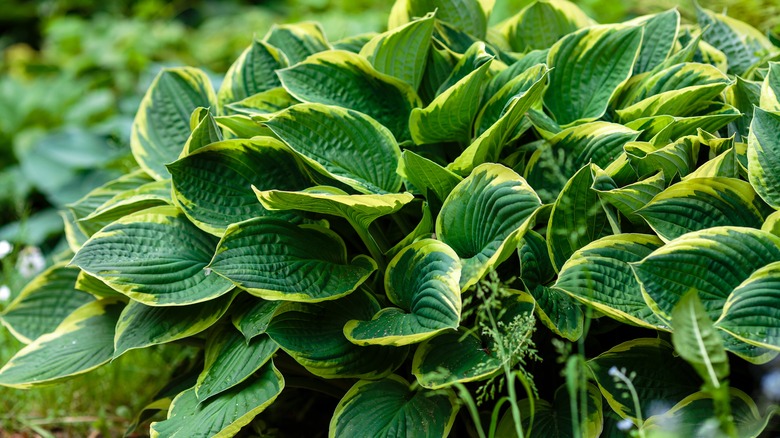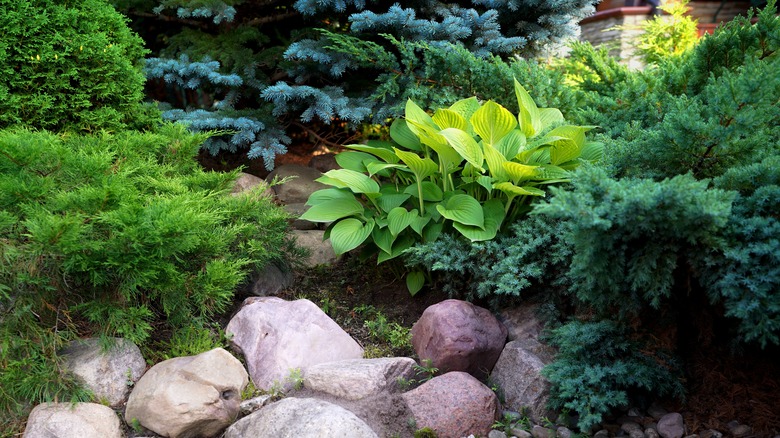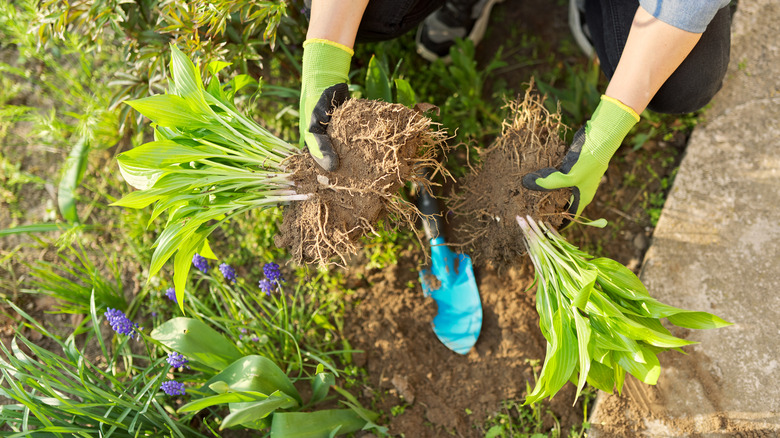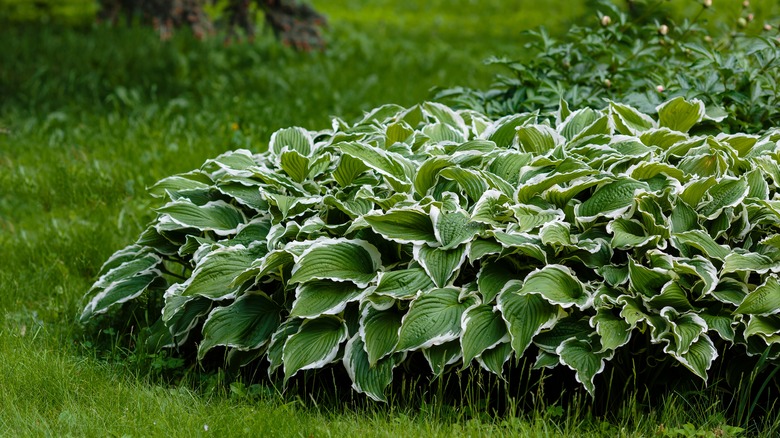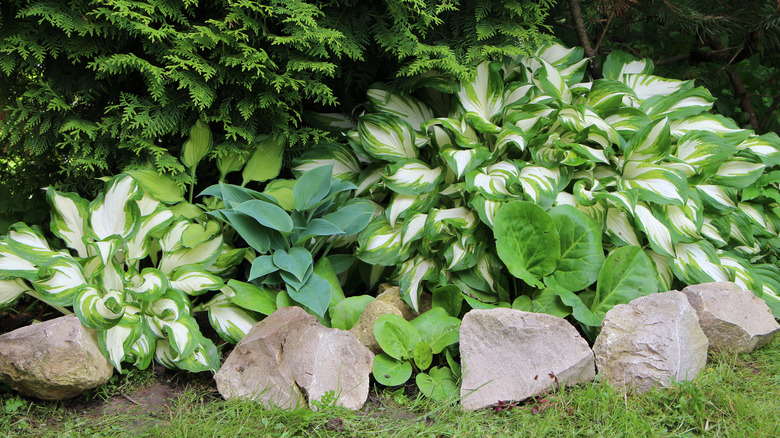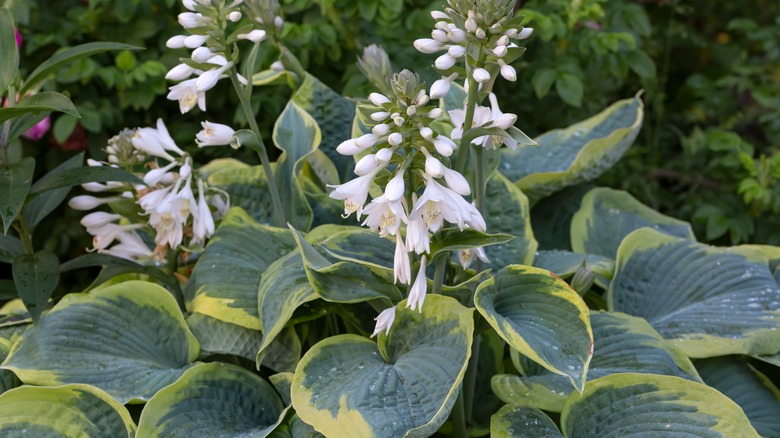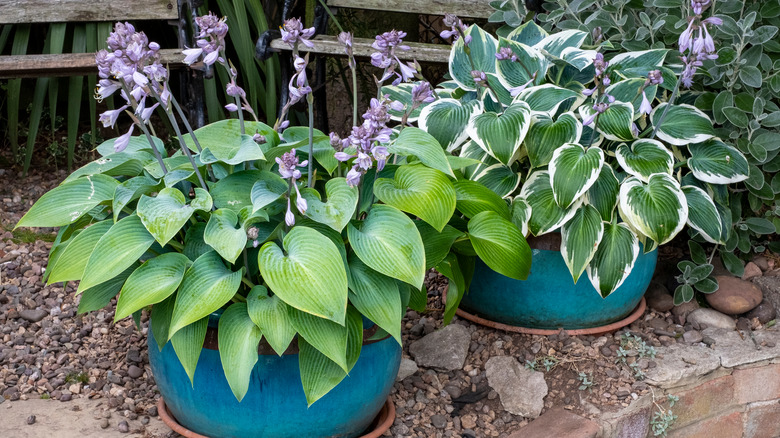How To Successfully Care For Hosta Plants
Hostas, also commonly known as plantain lilies, are a genus of shade-tolerant foliage plants that come in a wide range of colors, sizes, and shapes, as per Better Homes & Gardens. They can be found growing as low as 6 inches and reaching heights as tall as 3 feet. Their width depends on the specific variety, but as sprawling plants, hostas can spread up to 8 feet when fully grown. Some hostas sprout small blooms during the summer growing season that can be white or purple in color and typically let off a pleasant scent. The flowers grow along tall stalks that shoot out high above the foliage.
The highlight of this perennial plant is its variety of leaves. Unlike many other plants, the leaves of the hosta can provide just as much of a visual show as any flower. SFGate points out that you can find hostas with green leaves and yellow or white edges, and others with variegated colors that can include gold, blue-green, and gray-blue. In addition to color, hosta leaves vary in texture. Some are shiny and smooth while others feature patterned ridges. You can find both wavy and straight-edged leaves as well. Needless to say, there's a hosta for every preference.
You may be pleased to learn that hostas are generally easy-going plants that don't require much fuss on your part. Scroll through the following guide for everything you need to know about growing and caring for hostas.
How to use hostas in the garden
There are a variety of creative ways to plant hostas in the garden due to their differing sizes and shade-tolerant nature. American Meadows explains that while hostas can grow in heavy shade — such as underneath other plants and trees or in a corner of the yard that doesn't receive any sun — they won't reach their full potential and will appear smaller and weaker. It is best to find a partly shady area to be on the safe side. That being said, hostas are great candidates for ground cover plants given their tendency to spread outward rather than upward. They can fill in entire garden beds on their own or be used along borders and walkways. Smaller varieties can be planted in containers or at the front edge of garden beds to add a bit of texture.
You can also play with the colors of the hosta varieties you choose to draw the eye. More colorful hostas, such as those featuring gold embellishments on their leaves, work great in darker areas of your garden or planted among other foliage plants to add a bit of brightness. They can also serve as a pretty backdrop to perennially blooming flowers. American Meadows recommends a few hosta companion plants, including meadow rue, bleeding hearts, ferns, and coral bells. Make your hostas the focal point of a garden bed by framing them with taller plants.
How to grow hostas
Hostas are typically bought from a plant nursery already divided and placed in growing pots. You can also divide hostas yourself from mature plants in your garden. In the case of the former option, you'll want to purchase the variety of hosta that you want for your garden and pick up a bag of compost as well for added nutrition, according to The Home Depot. You should also have a trowel or shovel on hand to dig holes.
You should plant your hostas in the spring or summer, but not too close to the first frost of the fall — a minimum of one-month berth should be enough time. Once you've located a spot in your garden, get to work digging holes that are about a foot deep and 1.5 times the size of the root ball. If you're planting more than one hosta, shoot for a distance of 1 and 3 feet between each hole, depending on the variety. After you've dug the holes, add in a few inches of compost and situate the root ball in the hole, taking care to make it even with the soil level. Fill in the rest of the hole with soil and give each hosta a long drink of water.
To divide a hosta yourself, cut off an eye (a shoot growing from the base of the plant) while making sure you include as many roots as possible in the cut. Plant the eye following the above steps.
How to care for hostas
Hostas are relatively easy to care for as long as their basic needs are met. You'll have an easier time growing and maintaining your hostas if you live in USDA zones 3 to 9, as per The Spruce. While hostas are incredibly shade tolerant, you will need to make sure they receive some sunlight, preferably dappled, throughout the day to allow them to thrive. Too much sun can harm your hostas, however. You'll know you need to move them to a shadier spot if they start fading or turning brown at the tips of their leaves.
In addition to sun preferences, hostas also have a preference for soil type. They do best in well-draining soil with plenty of compost or other organic materials. You can add a layer of compost every spring as well as provide a bit of organic fertilizer during the growing season. Once mature, hostas do not need to be watered excessively. In fact, too much water can lead to root rot. A good rule of thumb is to make sure the soil is damp but not soggy. It is better for them to sit in dry soil than wet soil, but take care not to leave them too long without water.
One perk to growing hostas is that they tolerate temperature and humidity fluctuations, making them great for growing outdoors year-round as well as indoors. Hostas even require the cooler temperatures of winter to thrive the rest of the year.
Varieties of hosta
Hostas originated in the Eastern Hemisphere, specifically in the modern-day countries of China and Japan, as per Gardens of Bacchus. They made their way to Europe in the 1700s and then to the United States in the 1800s. Over the years, the number of varieties of hosta has grown to around 3,000 in total. This large variation in species allows for immense diversification in appearance, ensuring that there is a hosta that meets every gardener's needs and preferences. Among the most popular varieties in existence today is the Hosta 'Whirlwind,' which features a stunning pattern of swirling white and green leaves, as per Garden Lovers Club.
- Hosta 'Crispula' delights viewers with its curly leaves that are green in the middle and bordered in white. The leaves are also waxy to the touch, making them great for growing close to the ground.
- Hosta 'Gracillima' is a dwarf variety with stunning, deep-green leaves that should be considered if you're interested in planting hostas in containers.
- Hosta 'Blue Mouse Ears' is another great dwarf variety, stretching to a mere 5 inches when fully grown, according to Better Homes & Gardens.
- Hosta 'Daybreak' sits on the opposite end of the height spectrum, growing to a whopping 3 feet tall. It's also a looker with gold-green leaves and a ribbed texture.
- Host 'Great American Expectations' is one more variety on the taller end, hitting heights of around 2 feet when mature. Its leaves are light-green in the middle and edged in blue.
Are hostas toxic?
Not only are hostas non-toxic to humans, they are also edible, according to Plant Addicts. This plant is related to other edible plants, including agave, yucca, and asparagus, and is widely consumed in its native countries of Japan, Korea, and China. While the leaves can be included in dishes such as salads, the young shoots are the most popular part of the plant to consume, which are similar in appearance and function to asparagus. For the best taste, shoots are collected in the early spring when they first emerge from the soil and are still tender. They are then cooked in stir-fries and other dishes. When it comes to the leaves, the younger the better as well for a less-bitter taste. Leaves can be eaten raw or cooked.
Unfortunately, hostas are edible for humans but toxic for most animals, including cats, dogs, and horses. Consuming any part of the hosta plant can lead to extreme digestive upset, marked by vomiting, diarrhea, and other symptoms. In the case of accidental ingestion, you should contact your local emergency veterinary hospital or pet poison helpline for immediate treatment.
If you have pets and don't want to give up the opportunity to plant hostas in your garden, there are ways you can ensure your pets stay safe. A popular method is to apply a bitter spray to the hostas to discourage pets from eating the plant. You can also put up barriers to physically keep pets away.
How to repot hostas
Hostas do well planted in containers and pots, giving you the flexibility to move them around your garden where you see fit while also providing the opportunity to bring some nature onto decks, patios, and balconies. As the plants grow, however, you may need to repot them.
The British Hosta and Hemerocallis Society recommends repotting when you notice the roots emerging from the drainage holes in the pot or container. This will likely take place once a year while the plant is still growing. Other signs that your hosta is ready for a bigger home are browning or dying leaves and a general lack of well-being that can't be attributed to other causes. Note that hostas prefer being slightly more pot-bound, so you don't need to go overboard when choosing a new container — the next size up should work just fine.
When it comes time to repot your hosta, choose a well-draining soil rich in organic matter, as per Savvy Gardening. Place a couple of inches of soil and compost into the base of the container and then remove your hosta from its old pot, taking care to be gentle while shaking off any excess soil. When you situate the root ball in the new pot, ensure it doesn't extend above the lip of the container. Finally, fill in the pot around the root ball with more soil and finish up with some water. For continued maintenance, water a couple times a week.
